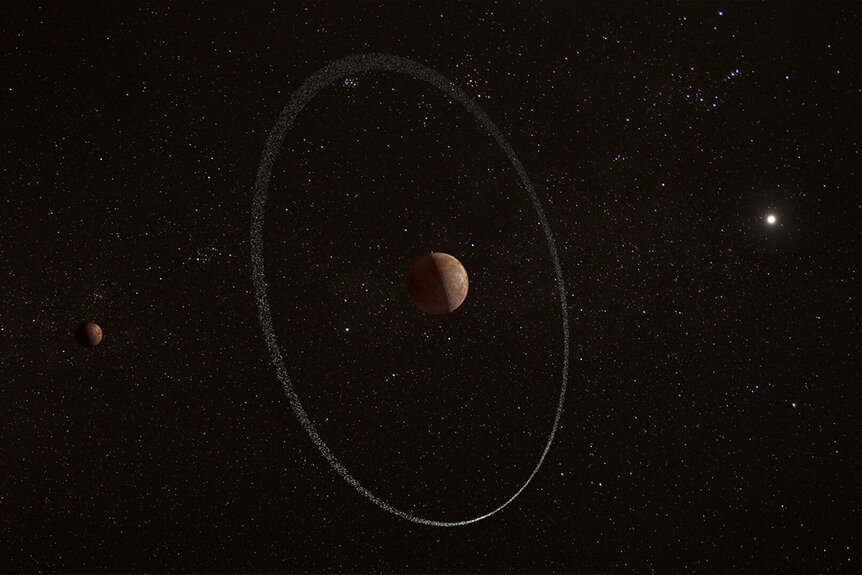Create a free profile to get unlimited access to exclusive videos, sweepstakes, and more!
Dwarf planet Quaoar has a ring system that defies our understanding of gravity
The ring is further away from the planet than gravity should allow.

On their way to a colony planet around Proxima Centauri b, roughly 4.2 light years from Earth, the crew of the Ark One suffers a species-threatening catastrophe while still a year away from their destination. The crew of SYFY's The Ark (now streaming on Peacock!), many of them untrained for the challenges at hand, must band together if they hope to survive the challenges of deep space travel. If they live to reach Proxima Centauri b, they’re certain to encounter all types of alien worlds on their final approach to their new home, but it turns out they need not have traveled so far.
In the distant parts of our own solar system, in the reaches beyond Neptune, you’ll find the frigid expanses of the Kuiper Belt. You can think of it like a second asteroid belt, only it’s much larger and filled with chunks of ice made of water, methane, and ammonia. Also like the asteroid belt, there are a smattering of relatively large worlds scattered in among the smaller ice shards. The most beloved of these worlds is Pluto, the largest of the minor planets, but Pluto isn’t alone out there. Seventh on the list of large Kuiper objects is the tiny world of Quaoar.
RELATED: ‘The Ark’ stars open up about how they formed a ‘Fellowship of the Ring’ while filming SYFY series
The small, icy world was named for the creator god of the Tongva, an indigenous people from Southern California, where the dwarf planet was discovered. Quaoar is approximately 1,100 kilometers in diameter, roughly half the size of Pluto, and has a single moon called Weywot, named for Quaoar’s son. It orbits way out there, at a distance of about 44 astronomical units (roughly 4 billion miles) from the Sun.
The minor planet was first discovered in 2002, by astronomers at the California Institute of Technology and has remained an area of interest. Now, using the ESA’s Cheops (Characterizing Exoplanet Satellite) instrument, astronomers have made a bizarre discovery about this distant, tiny world. It has a ring system and it is way farther away from Quaoar than it should be. That’s according to a recent study published in the journal Nature.
When it comes to ringed worlds, everyplace else trails behind Saturn’s tremendous lead. Saturn itself is a hulking beast with a diameter of 72,400 miles (116,500 kilometers), but the rings stretch much farther. Their collective diameter clocks in at 170,000 miles (270,000 kilometers), roughly 2.34 times that of the planet. The rings are an incredible and awe-inspiring expanse of material so large in the night sky they can be seen with a small telescope or pair of binoculars. But they aren’t any more distant than they should be, thanks to the Roche Limit.
That’s the line around a planet or other large object at which an orbiting object will be torn to pieces by the larger object’s gravity. For instance, if the Moon were to come nearer to the Earth than 11,470 miles (18,470 kilometers) above the surface, the Earth’s gravity would overcome the Moon’s internal gravity and rip it to shreds. Fortunately for us, the Moon’s pieces wouldn’t continue falling toward the Earth. Instead, they would enter into orbit around the Earth in a magnificent ring. That’s probably how Saturn got at least some of its rings, and it’s how we expect most places get them. It also means that we expect ring systems to be inside of their parent world’s Roche Limit and that’s where Quaoar gets weird.
RELATED: Dwarf planets can have rings, too, if they’re lumpy or oblate
Our understanding of ring systems says that material orbiting a planet (or a dwarf planet) outside of the Roche Limit should coalesce into a Moon relatively quickly, within a few decades. However, observations of Quaoar taken with Cheops as well as ground-based telescopes reveal a ring at a distance of nearly 7.5 times the diameter of Quaoar, well outside of its Roche Limit.
Cheops identified the ring by looking at Quaoar in much the same way it normally looks at exoplanets. Astronomers waited until Quaoar passed in front of distant stars, like a small and narrow eclipse. Scientists measured the light collected from the star before, during, and after the occultation, and used the dimming to learn about Quaoar. That dimming can provide information about size, shape, and atmospheric data if it exists. Astronomers saw the expected dimming as Quaoar passed in front of their target star, but they also saw a smaller dip before and after, revealing the presence of the ring.
That the ring persists well outside of Quaoar’s Roche Limit means that our understanding of ring dynamics needs to be reworked. Clearly, something is amiss. Astronomers hypothesize that the incredibly cold temperatures in the Kuiper Belt may contribute to the ring not sticking together as it should, but we’re going to need more data before we’ll figure out what’s really going on.
While we’re waiting for an explanation for Quaoar’s weird behavior, catch up on The Ark. Episodes air on SYFY every Wednesday at 10 p.m. ET, and stream on Peacock the next day!































